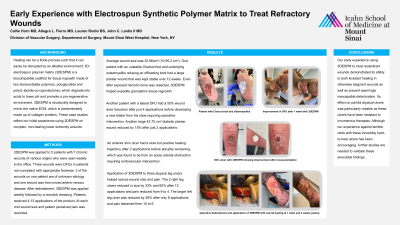Case Series/Study
(CS-070) Early Experience with Electrospun Synthetic Polymer Matrix to Treat Refractory Wounds

Healing can be a fickle process such that it can easily be disrupted by an alkaline environment. 3D-electrospun polymer matrix (3DESPM) is a biocompatible scaffold for tissue ingrowth made of two bioresorbable polymers, polyglycolide and poly(L-lactide-co-caprolactone), which degrade into acids to lower pH and promote a pro-regenerative environment. 3DESPM is structurally designed to mimic the native ECM, which is predominately made up of collagen proteins. These case studies reflect our initial experience using 3DESPM on complex, non-healing lower extremity wounds.
Methods:
3DESPM was applied to 5 patients with 7 chronic wounds of various origins who were seen weekly in the office. Three wounds were DFUs in patients non-compliant with appropriate footwear, 3 of the wounds on one patient are of unknown etiology and one wound was from mixed arterio-venous disease. After debridement, 3DESPM was applied weekly followed by a nonstick dressing. Patients received 4-12 applications of the product. At each visit wound size and patient perceived pain was recorded.
Results: Average wound size was 32.96cm² (10-95.2 cm²). One patient with an unstable Charcot foot and underlying osteomyelitis refusing an offloading boot has a large plantar wound that was kept stable over 12 weeks. Even after exposed necrotic bone was resected, 3DESPM helped expedite granulation tissue regrowth. Another patient with a lateral DFU had 50% wound area reduction after just 4 applications before developing a new blister from his shoe requiring operative intervention. Another large 42.75 cm² diabetic plantar wound has reduced by 15% after just 3 applications thus far. Application of 3DESPM to 3 atypical leg ulcers helped reduce wound size and pain. The 2 right leg ulcers reduced in size by 33% and 60% after 12 applications and pain reduced from 9 to 4. The larger left leg ulcer reduced by 28% after only 6 applications and pain lessened from 10 to 6. An anterior shin ulcer had a slow but positive healing trajectory after 2 applications before abruptly worsening, which was found to be from an acute arterial obstruction requiring endovascular intervention.
Discussion:
Our early experience using 3DESPM to treat recalcitrant wounds demonstrated its ability to both kickstart healing in otherwise stagnant wounds as well as prevent seemingly inescapable deterioration. Its effect on painful atypical ulcers was particularly notable as these ulcers have been resistant to innumerous therapies. Although our experience against terrible odds with these incredibly hard-to-heal ulcers has been encouraging, further studies are needed to validate these anecdotal findings.
Trademarked Items: PHOENIX Wound Matrix, RenovoDerm®, Dublin, OH
References:

.png)